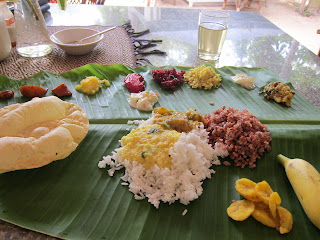The order in which we eat different classes of foods, how we
combine them, and the amounts we consume will determine how well we digest and
assimilate our vital nutrients. The better we digest and assimilate our foods,
the less likely we are to form toxic substances, accumulate excess fat, and
crave unhealthy food articles.
According to Ayurveda, every food has its own taste (rasa),
a heating or cooling energy (virya) and post-digestive effect (vipaka). When
two or three different food substances of different taste, energy and
post-digestive effect are combined together agni can become overloaded
inhibiting the enzyme system and resulting in production of toxins in the
system. While it is true that an individual's agni largely determines how well
or poorly food is digested, food combinations are also of great importance.
When foods, (proteins, carbohydrates and fats) having different attributes,
tastes, heating or cooling properties, and post-digestive effects are eaten
together, agni will be slowed down. The foods can then remain in the stomach
for seven to eight hours. These same foods, if eaten separately might well
stimulate agni, be digested more quickly and even help to burn ama. Thus,
according to Ayurveda, one should eat according to one's constitution and take
fruits, starches, proteins and fats separately at different times of the day.
Combining foods improperly can produce indigestion, fermentation, putrefaction
and gas formation. This condition, if prolonged, can lead to toxemia and
disease complex. For example, eating bananas with milk can diminish agni,
change the intestinal flora producing toxins and may cause sinus congestion,
cold, cough and allergies.
The principles of Ayurvedic food combining are derived from
written information left us in the ancient writing of the Indian physicians
living around 100 A.D.. The basic difference from how we are used to eating
today is that they only ate two or three different types of foods at any one
meal. We tend to have at least six or seven (if not more) types of food at most
meals. Foods should not be too fancy. Gourmet foods with rich, sweet tastes
will influence even the most strong-willed, health-conscious person to
overindulge. Foods should be simple and naturally delicious.
Some important recommendations of
Ayurvedic Food Combining include:
· Avoid
taking milk or yogurt with sour or citrus fruits.
· Avoid
eating fruits together with potatoes or other starchy foods. Fructose(fruit
sugar) (and other sugars) is digested quickly, whereas starch takes quite some
time. In this case the sugar would not be properly digested.
· Avoid
eating melons and grains together. Melons digest quickly whereas grains take
more time. This combination will upset the stomach.
· Melons
should be eaten alone or left alone.
· Honey
should never be cooked. Honey digests slowly when cooked and the molecules
become a non-homogenized glue which adheres to mucous membranes and clogs
subtle channels, producing toxins. Uncooked honey is nectar. Cooked honey is
poison.
· Do
not eat meat protein and milk protein together.
· Milk
and melons should not be eaten together. The action of hydrochloric acid in the
stomach causes the milk to curdle. For this reason Ayurveda advises against
taking milk with sour fruits, yogurt, sour cream, cheese, and fish.
· Cold
beverages should not be consumed during or directly after a meal as it reduces
agni and digestion. Small sips of warm or tepid water taken during the meal
serves to aid digestion.
· While
eating one should properly masticate the food in order to soften it and ensure
that it is thoroughly mixed with saliva.
· Vata
and Pitta constitutions may finish a meal by drinking a cup of lassi. This can
be made by blending four tablespoons of yogurt with pinches of ginger, fennel
powder, and cumin powder in 3/4 cup of water.


No comments:
Post a Comment
Note: Only a member of this blog may post a comment.